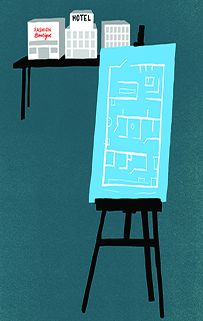Learn By Example
With more than $1 billion in current investment in 17 states, microhospitals are spreading as developers apply lessons learned in the commercial real estate sector to healthcare.
These small-scale versions of conventional hospitals are bringing convenient access to care closer to patient populations, similar to the way freestanding emergency departments (EDs) now permeate city landscapes. The two models share many of the same characteristics, as well.
A microhospital expands on the ED base, though, by offering acute care, advanced surgical capabilities, and overnight beds. A typical facility provides 10 to 20 beds, imaging, pharmacy, lab, surgical, and clinical space—all in about 30,000 to 40,000 square feet. Slightly larger versions include clinical space for specialists or general practitioners and/or post-acute services, creating a mini medical campus.
Due to the small format, many microhospitals limit their scope of care to fit local demographic characteristics. For example, where residents are predominately young, a facility may specialize in obstetrics and gynecology. In an older community, a small heart hospital with critical-care observation space may be more appropriate. Other microhospitals may limit services to a specialization such as spinal surgery or cardiac care. In concert with a large parent hospital, a suburban specialty microhospital could enjoy brisk business by providing complex procedures and a concierge-like postoperative program. That revenue stream can help to offset the higher cost of operations and larger proportion of indigent or unpaid care provided at the main campus.
Regardless of specialization, microhospitals, with their limited service lines, are more likely to achieve above-average patient outcomes. Usually Level 4 or 5 trauma facilities with higher nurse-to-patient ratios, microhospitals handle few severe trauma cases and generally incur infection and mortality rates far lower than national
averages for hospitals due to the low acuity of care provided.
To fully understand the microhospital model, it helps to consider the features it shares with other commercial property types. This trend may be new to healthcare, but it represents a coalescence of successful strategies borrowed from retail, office, hospitality, and even industrial real estate.
Retail appeal
Healthcare systems competing for market share seek inroads into the communities where current and prospective patients live, work, and play. Toward that end, they’re taking cues from the retail stores that populate highly visible power centers and shopping complexes at major crossroads. Like stores, many microhospitals and medical office buildings are built near main thoroughfares or are adjacent to transportation hubs, with ample parking and ease of access for patients.
Owing to the relatively small footprint of microhospitals, investors are identifying promising sites using the same tools developers use to select locations for retail projects. Hot-spot data mapping and traffic pattern analysis software can highlight areas with the desired demographic mix, convenient to populations that have been underserved by existing or remote healthcare options.
Hospitality lessons
Like hoteliers, microhospital planners use research and carefully vetted demand analyses to provide a targeted product that not only meets local healthcare needs but is also tailored to fit the community.
Hospital operators are studying up on hospitality, as well. Given the pivotal importance of outcomes and patient satisfaction in healthcare today, providers are devoting much greater thought to the patient experience. Health system administrators are looking for ways to enhance the customer service aspect of their hospitals, not just in care delivery or post-surgery follow-up, but also in the marks of good hospitality such as locational convenience, wait times, food service, and cleanliness.
As hospitals glean best practices from the hotel industry, developers can incorporate these measures into the design of new microhospitals. And the small scale of a microhospital gives operators the opportunity to devote a high degree of personal attention to each patient. For example, a microhospital may choose to provide patients with gourmet or cooked-to-order meals, a luxury that a full-size hospital feeding 100 or more patients may deem impractical. Some facilities are providing hotel-type visiting space for patient guests, with higher-end seating and workstations or even sleeping accommodations.
Office and industrial contributions
Unlike a traditional metropolitan hospital, which requires caregivers and patients near and far to make a trek to its central campus, microhospital locations usually reflect physician and patient preferences for convenience. Like office developers, the investors behind a new microhospital will strive to provide amenities like covered parking, convenient building access, and a location close to desired restaurant and shopping areas that make the property more appealing to employees and patients. Placing the facility within the submarket it serves offers employees a short commute and lets patients recover from their medical procedures close to home.
A key to the microhospital value proposition is an efficient design that groups essential features into a microcosm of a full-sized hospital. Workplace optimization methods pioneered in the manufacturing and office sectors help planners minimize the square footage required to complete workplace tasks while improving overall pedestrian flow and utilization of the space, its fixtures, and equipment. Everything from the ED to imaging, pharmacy, lab, surgical rooms, and back-office space must be sized and positioned to meet anticipated demand levels while providing opportunities to reduce overall staffing. The idea is to maximize utility while avoiding unnecessary storage and staffing, which run up costs.
A viable option
Properly executed, the cost to construct microhospitals is often less than the expense of expanding an existing facility with a similar number of beds and associated services. Construction times tend to be quicker, too: The design and construction window for a facility of that size averages only 18 to 20 months. Once completed, a microhospital’s efficient layout and economy of space typically translates into operating costs lower than hospitals can achieve for comparable services.
There’s no universal hospital design fitting all communities. The chief advantages of microhospitals are a more manageable size and greater flexibility than a conventional flagship hospital. While microhospitals won’t replace the regional hospital and campus of associated practices, they offer healthcare systems a means to extend inpatient services into remote or underserved patient populations, and at a fraction of the expense and time required to develop a full-size hospital.
Robert Garcia is vice president of healthcare advisory services at Transwestern. He can be reached at Robert.Garcia@transwestern.com.



